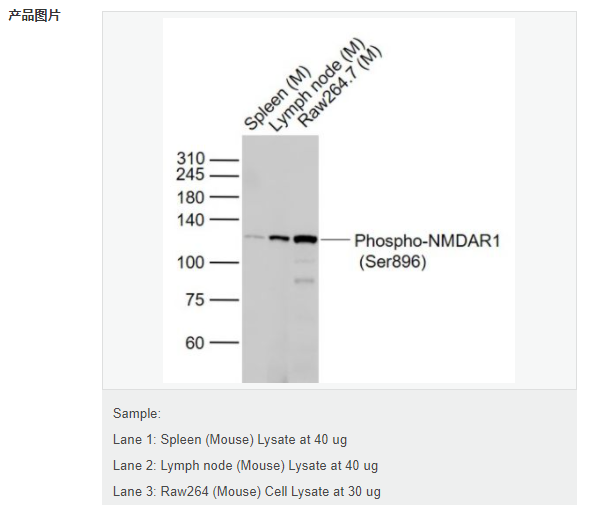

貨號
產(chǎn)品規(guī)格
售價
備注
BN40895R-100ul
100ul
¥2470.00
交叉反應(yīng):Human,Mouse(predicted:Rat,Chicken,Dog,Cow) 推薦應(yīng)用:WB,IHC-P,IHC-F,IF,ELISA
產(chǎn)品描述
| 英文名稱 | Phospho-NMDAR1 (Ser896) |
| 中文名稱 | 磷酸化離子型谷氨酸受體1抗體 |
| 別 名 | NMDAR1 C1 (phospho S896); p-NMDAR1 C1 (phospho S896); NMDAR1(Phospho-Ser896); NMDAR1(Phospho-S896); NMDAR1 C1 (phospho S896); p-NMDAR1(S896); p-NMDAR1(Ser896); NMDA-NR1; N-Methyl-d-Asprtate receptor 1; GRIN1; NMDA1; NR1; Glutamate [NMDA] receptor subunit zeta 1; Glutamate receptor ionotropic N methyl D aspartate 1; Grin 1; Grin1; N methyl D aspartate receptor channel; N-methyl-D-aspartate receptor; N-methyl-D-aspartate receptor subunit NR1; NMD-R1; NMDA 1; NMDA NR1; NMDA R1; NMDA receptor 1; NMDA1; NMDAR 1; NMDAR; NR 1; NMDZ1_HUMAN. |
| 產(chǎn)品類型 | 磷酸化抗體 |
| 研究領(lǐng)域 | 細(xì)胞生物 免疫學(xué) 神經(jīng)生物學(xué) 信號轉(zhuǎn)導(dǎo) 轉(zhuǎn)錄調(diào)節(jié)因子 激酶和磷酸酶 細(xì)胞類型標(biāo)志物 |
| 抗體來源 | Rabbit |
| 克隆類型 | Polyclonal |
| 交叉反應(yīng) | Mouse, (predicted: Human, Rat, Chicken, Dog, Cow, ) |
| 產(chǎn)品應(yīng)用 | WB=1:500-2000 ELISA=1:5000-10000 IHC-P=1:100-500 IHC-F=1:100-500 ICC=1:100-500 IF=1:100-500 (石蠟切片需做抗原修復(fù)) not yet tested in other applications. optimal dilutions/concentrations should be determined by the end user. |
| 分 子 量 | 103kDa |
| 細(xì)胞定位 | 細(xì)胞膜 |
| 性 狀 | Liquid |
| 濃 度 | 1mg/ml |
| 免 疫 原 | KLH conjugated Synthesised phosphopeptide derived from human NMDAR1 around the phosphorylation site of Ser896:RR(p-S)SK <Cytoplasmic> |
| 亞 型 | IgG |
| 純化方法 | affinity purified by Protein A |
| 儲 存 液 | 0.01M TBS(pH7.4) with 1% BSA, 0.03% Proclin300 and 50% Glycerol. |
| 保存條件 | Shipped at 4℃. Store at -20 °C for one year. Avoid repeated freeze/thaw cycles. |
| PubMed | PubMed |
| 產(chǎn)品介紹 | The protein encoded by this gene is a critical subunit of N-methyl-D-aspartate receptors, members of the glutamate receptor channel superfamily which are heteromeric protein complexes with multiple subunits arranged to form a ligand-gated ion channel. These subunits play a key role in the plasticity of synapses, which is believed to underlie memory and learning. Cell-specific factors are thought to control expression of different isoforms, possibly contributing to the functional diversity of the subunits. Alternatively spliced transcript variants have been described. [provided by RefSeq, Jul 2008] Function: NMDA receptor subtype of glutamate-gated ion channels with high calcium permeability and voltage-dependent sensitivity to magnesium. Mediated by glycine. This protein plays a key role in synaptic plasticity, synaptogenesis, excitotoxicity, memory acquisition and learning. It mediates neuronal functions in glutamate neurotransmission. Is involved in the cell surface targeting of NMDA receptors. Subunit: Forms heteromeric channel of a zeta subunit (GRIN1), a epsilon subunit (GRIN2A, GRIN2B, GRIN2C or GRIN2D) and a third subunit (GRIN3A or GRIN3B); disulfide-linked. Found in a complex with GRIN2A or GRIN2B, GRIN3A or GRIN3B and PPP2CB. Interacts with DLG4 and MPDZ. Interacts with LRFN1 and LRFN2. Interacts with MYZAP. Subcellular Location: Cell membrane; Multi-pass membrane protein. Cell junction, synapse, postsynaptic cell membrane. Cell junction, synapse, postsynaptic cell membrane, postsynaptic density. Post-translational modifications: NMDA is probably regulated by C-terminal phosphorylation of an isoform of NR1 by PKC. Dephosphorylated on Ser-897 probably by protein phosphatase 2A (PPP2CB). Its phosphorylated state is influenced by the formation of the NMDAR-PPP2CB complex and the NMDAR channel activity. DISEASE: Defects in GRIN1 are the cause of mental retardation autosomal dominant type 8 (MRD8) [MIM:614254]. Mental retardation is characterized by significantly below average general intellectual functioning associated with impairments in adaptative behavior and manifested during the developmental period. Similarity: Belongs to the glutamate-gated ion channel (TC 1.A.10.1) family. NR1/GRIN1 subfamily. SWISS: Q05586 Gene ID: 2902 Database links: Entrez Gene: 2902 Human Entrez Gene: 14810 Mouse Omim: 138249 Human SwissProt: Q05586 Human SwissProt: P35438 Mouse Unigene: 558334 Human Unigene: 278672 Mouse Unigene: 9840 Rat Important Note: This product as supplied is intended for research use only, not for use in human, therapeutic or diagnostic applications. 神經(jīng)細(xì)胞標(biāo)志物 (NMDAR1)N-甲基-D-天門冬氨酸受體(NMDAR)是興奮性氨基酸受體亞型之一,是由NMDAR1與不同的NMDAR2亞基組成的異聚體。 NMDAR1又稱GluR1 (Glutamate Receptor 1)近年實驗研究發(fā)現(xiàn),許多NMDAR拮抗藥均具有鎮(zhèn)痛活性,表明NMDAR在痛覺傳遞中具有重要作用,這為新型鎮(zhèn)痛藥的研究開發(fā)提供了新的作用靶點。 |
